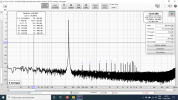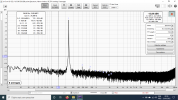@KSTR, John from Benchmark
posted "All D/A converter chips produce significant common-mode distortion on the balanced outputs. This unwanted common-mode distortion is easily removed with a differential amplifier. If it is not removed, the result is IMD...
...This IMD (and THD) is a direct result of omitting a differential amplifier after the output of the chip...the solution is to place a well trimmed differential amplifier at the balanced outputs of the D/A chip"
Now the KTB has a standard subtractor stage (with another 1st order filter) after the I/V's so it should do basic CM cancelling fine to about -30dB CMRR.
Anyway, yesterday I closely examined the individual I/V outputs to check for CM content and general behavior and found some interesting things that need more exploration (as time allows)...
With the proper amount of digital DC bias I could manage a stable operating point where for that I/V all distortion is even-order only (still an excessive train, though). This would allow for cancelling with the other I/V... if only it could be made to have the
same polarity DC bias.
Alas, the DC in the test signal of course is applied
mirrored and then the even-order only condition breaks because it is the wrong bias for the other I/V. But it is a pointer in the right direction that good degree of cancelling is possible when both I/Vs have the same even-order-only profile.
Waiting for the D10B to arrive now, as I'm really curious what the fine-print in the residual is for them.




